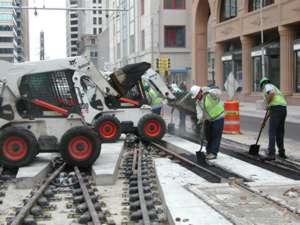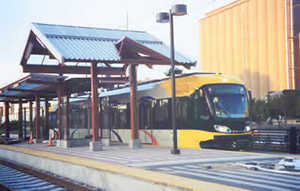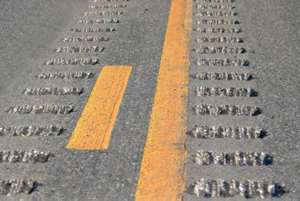 |
 |
|
 |
Workiní on the LRT: building, testing roll on Hiawatha rail line |
 |
 |
 |
Construction crews work on completing the light rail track crossover
between Nicollet Mall and Hennepin Avenue in downtown Minneapolis. Photo
by Josh Collins
|
Fall colors fade and chillier temperatures settle in, but construction continues
briskly along the Hiawatha light rail transit corridor. Construction will carry
on at its normal pace between downtown Minneapolis and Bloomington until the
ground freezes.
With more than a million construction labor hours clocked on the project so
far, it is not difficult to see that hard work has led to substantial progress
on the Twin Cities metro area's first light-rail line.
While Mn/DOTís general contractor puts the finishing touches on the Minneapolis
segments, crews continue to move earth and lay track throughout Bloomington.
Winter weather will not slow crews laying track sheltered inside the twin tunnels
under the Minneapolis-St. Paul International Airport.
With track and stations largely complete throughout Minneapolis, this fall
crews focus on installing electrical components, signals and gate arms at grade
crossings as well as the poles and wires that will deliver power to the fleet
of light-rail vehicles being assembled at the LRT Maintenance Facility at Cedar
Avenue and I-94 in south Minneapolis.
 |
The Hiawatha LRT test car pauses at the 38th Street station in south
Minneapolis. The train rests between two dominant architectural themes
of the area: the grain elevators along Hiawatha Avenue and the station
which reflects the bungalow design of many homes in the cityís Longfellow
neighborhood. Photo by Craig Wilkins
|
Construction is on track to have the Hiawatha Line ready for operation in April
2004 between downtown Minneapolis and Fort Snelling. This means that crews will
soon pack up their tools and move south to focus on completing rail facilities
in the airport and Bloomington segments.
After the holiday season, crews expect to begin work in the intersection of
24th Avenue and Killebrew Drive near the Mall of America. This work will be
among the last segments that will have significant impact to traffic movements
along the line.
And while construction on the line continues, so does testing of the prototype
Hiawatha LRT vehicle. Area residents often see the train at night logging the
necessary miles to ensure it meets all safety and operational requirements.
"There is no slowing down for us now," said John Caroon, Mn/DOT design-build
project manager for the Hiawatha Project Office. "With trains out there testing
on our tracks, it is more clear than ever that the finish line is in sight."
Check out the Hiawatha light
rail transit Web site for more information.
By Josh Collins
|
back

|
 |
Recent rail crossing fatalities signal alarming trend |
 |
 |
Two recent crashes at Minnesota railroad crossings that claimed five young
lives have prompted Mn/DOT and the Minnesota Operation Lifesaver to remind drivers,
bikers and pedestrians to use caution at highway-railroad grade crossings.
Four people were killed on Sept. 26 in a train-vehicle crash on Hwy 47 in Anoka;
one person was killed on Sept. 29 in a bike-train crash at Fourth Street in
Moorhead. In the past 10 years, there has been a significant decrease in the
number of crashes at highway-rail crossings in Minnesota. These recent crashes
slow that trend.
The number of crashes at Minnesota rail crossings declined from 144 in 1994
to 72 in 2002. So far this year, 28 crashes have been reported at rail crossings.
In 2002, nine people died in crashes at rail crossings. In 2003, there have
been eight fatalities in nine months.
"Rail crossings are dangerous and require people to pay attention and
be smart," said Al Vogel, Mn/DOTís director of Freight, Railways and Waterways.
"Safe driving, biking and walking behavior can and does save lives."
According to Mike Langer, Minnesota Operation Lifesaver state coordinator,
rail-crossing fatalities could be prevented if people were more aware of the
dangers trains pose.
"Because of their size, approaching trains appear to be traveling at a
slower speed," Langer said. "It takes a fully loaded freight train
traveling at 50 miles an hour 1.5 miles to come to a full stop. By the time
the train engineer sees a vehicle or pedestrian on the tracks, it is often too
late to react safely."
Langer said drivers, bikers and pedestrians should be aware of the following:
-
Lowered gates indicate a road is closed and vehicles are prohibited from
crossing.
-
Thirty-five percent of train-vehicle crashes in Minnesota occur at crossings
with active warning devices (flashing lights and/or gates). Driving around
lowered crossing gates is the equivalent of driving through a red light
traffic signal and is a misdemeanor offense.
-
Trains have the right-of-way at highway-rail crossings; all vehicles are
required by law to yield.
-
Drivers and pedestrians should always expect a train because trains can
run on any track at any time.
"We could exceed last yearís rail crossing fatalities if this worrisome
trend of fatalities continues in 2003," Vogel said. "By issuing this
safety alert we hope to help prevent further injury, death and property damage."
Minnesota Operation Lifesaver is a non-profit public education and awareness
program dedicated to preventing collisions, fatalities and injuries at highway-rail
grade crossings and on railroad rights-of-way. For more information on highway-railroad
grade crossing safety, visit the Operation Lifesaver, Inc. Web site at www.oli.org.
By Donna Lindberg
|
back

|
 |
Winter driving safety campaign goes to the Metrodome |
 |
 |
Mn/DOTís Metro District will urge motorists not to tangle with snowplows when
the University of Minnesotaís Golden Gophers football team takes on the University
of Indiana on Saturday, Nov. 1, at the Metrodome in Minneapolis.
The game begins at 11 a.m.
Staff from Metro will give football fans a close-up look at a Mn/DOT snowplow
and hand out flyers and other materials urging them to drive carefully during
the winter.
Snowplow operators will be on hand by the plow to answer questions and share
their knowledge of safe winter driving practices. The plow will be displayed
on the plaza in front of the Metrodome.
In addition, public announcements about winter driving safety will be made
throughout the game.
"Having a presence at the Dome gives us a chance to speak with people
individually and to stress the importance of driving with extra caution and
giving snowplows plenty of room to work," said Kevin Walker, a Metro public
affairs coordinator.
A package that includes a ticket, a hot dog and a soda is available for $11.
To order tickets call 612/624-8080 or 800/U-GOPHER or via the Web at www.gophersports.com.
By Craig Wilkins
|
back

|
 |
Parker appointed as government relations director |
 |
 |
 |
Betsy Parker is the new director of the Office of Government Relations.
Photo by Dave Gonzalez
|
Betsy Parker, a career Mn/DOT employee and the current associate director of
government relations, was named as Mn/DOTís government relations director. Parker
succeeds Tim Worke, who resigned in July to accept a position with the Associated
General Contractors.
Parkerís career with Mn/DOT began in 1977 and progressed through several assignments
including director of the former Office of Motor Carrier Services from 1989
until 1996, when she assumed her current assignment in Government Relations.
Her primary responsibilities included developing Mn/DOTís legislative initiatives.
In announcing her appointment, Bob McFarlin, assistant to the commissioner
for policy and public affairs, said, "Betsyís extensive legislative experience
and knowledge of Mn/DOT issues will be great assets as we tackle the transportation
policy challenges that face us in the future."
Parker holds a bachelorís degree in humanities from Stephen F. Austin State
University in Texas and a law degree from the William Mitchell College of Law
in St. Paul.
|
back

|
 |
Rumble strips installed to reduce chances of fatal crashes |
 |
 |
 |
Centerline rumble strips are installed on Hwy 371 between Pequot Lakes
and Pine River. Photo by Jenny Seelen
|
Editorís note: The following article recently was printed in the Brainerd
Daily Dispatch.
Each year during the past five years, an average of 14 fatal head-on and sideswipe
vehicle crashes occurred on central Minnesotaís heavily traveled two-lane highways.
This trend prompted the District 3 staff to examine projects and engineering
techniques that would put the brakes on the disturbing annual number of fatal
crashes.
In response, Mn/DOT installed centerline rumble strips in 2000 on nearly 50
miles of Hwy 23 in Stearns and Kandiyohi counties to improve safety. The rumble
strips are designed to alert motorists driving too close to the opposite travel
lane or who cross over the centerline into the opposing lane of traffic.
Preliminary results of using rumble strips are favorable. Market research,
for example, found that drivers believed the rumble strips did improve safety
by making them more aware of their location within the driving lane. Those results,
coupled by similar findings in states such as Colorado, Delaware, Oregon, Pennsylvania,
and Washington are encouraging.
 |
The finished product: centerline rumble strips after they've been cut
into the pavement on Hwy 371. Photo by Jenny Seelen
|
That's why Mn/DOT recently installed centerline rumble strips on an additional
190 miles of rural two-lane highways throughout central Minnesota. The highways
with rumble strips include Hwy15, Hwy 18, Hwy 23, Hwy 25, Hwy 55, Hwy 65, Hwy
95, Hwy 169, Hwy 210 and Hwy 371.
According to a recent study by the Insurance Institute for Highway Safety,
the overall frequency of crashes on roads with rumble strips was reduced 14
percent. Crashes resulting in injuries were reduced by 15 percent. Head-on and
opposing-direction sideswipe crashes, the primary target of centerline rumble
strips, were reduced by 21 percent. Similar crashes involving injuries were
reduced by 25 percent.
There are, however, concerns about using rumble strips. People living adjacent
to the roadways with rumble strips have concerns about increased noise, while
crews charged with maintaining the roadway also have concerns--all of which
warrant further study. These issues and more will be studied during the next
three years as part of a comprehensive research effort to further refine this
engineering tool to save lives by reducing crashes and injuries.
It is unfortunate that such a technique has a negative effect of increased
noise to adjacent residents. Yet, in our opinion, it would be irresponsible
not to take the action, trying to make our highways safer. I hope vehicle crash
avoidance systems will soon make the centerline rumble strip a relic of the
past.
By Gary Dirlam, District 3 traffic engineer
|
back

|
 |
Combined Charities Campaign seeks contributions from state employees |
 |
 |
 |
The state employees' annual Combined Charities Campaign begins Oct.
27 and runs through Nov. 7.
|
"Now More than Ever" serves as the theme for this yearís Combined
Charities Campaign that begins Oct. 27 and runs through Nov. 7.
Mn/DOT annually participates in the Combined Charities Campaign in which all
Minnesota state agencies jointly raise money for a variety of charitable causes.
"Last year, Mn/DOT employees contributed $64,500 of the total $950,000
that was raised across the state," said Ron Bisek, Mn/DOTís campaign coordinator.
"The statewide goal for this yearís campaign is $1 million."
The program allows employees to make donations via payroll deductions throughout
the year or with a one-time offering.
"If every Mn/DOT employee pledged a mere $1 per paycheck a year, Mn/DOT
would raise more than $125,000," Bisek said.
There will be no hard copy pledges accepted this year. Employees must submit
their pledges electronically using the self-serve state employee Web site at
www.state.mn.us/employee, which
is the same site used to view pay stubs.
Those interested in donating time as well as money can assist by distributing
materials, publicizing the campaign and helping individual employees understand
the new pledging process.
"This campaign is very rewarding, and I hope employees take this opportunity
to give back to their communities," said Lt. Gov./Commissioner Carol Molnau,
who serves as the honorary chairperson for this yearís campaign. "Thereís
nothing more gratifying than Minnesotans helping out other Minnesotans in need."
For more information about the Combined Charities Campaign, visit the www.charities.state.mn.us.
For offices interested in appointing someone to coordinate their officeís campaign,
contact Ron Bisek at 651/296-1361 or ron.bisek@dot.state.mn.us.
By Daneeka Marshall-Oquendo
|
back

|
 |
New on Web: ICI site provides innovative information to speed up project delivery
|
 |
 |
 |
The new Innovative Construction Initiative Web site serves as a resource
for Mn/DOTís partners, stakeholders and employees.
|
The new Innovative Construction Initiative Web site serves as
a resource for Mn/DOTís partners, stakeholders and employees as they work to
accelerate the development and construction of highway projects.
This site currently features extensive information on the design-build method,
providing links and documents that assist in the design-build contract process.
The site will also serve as a clearinghouse for other innovative methods being
researched and used to speed up the pre-construction and construction processes
such as warranties, contracting, land acquisition and utility relocation practices.
The Web site can be viewed at www.dot.state.mn.us/information/ici.
Contact the Innovative Construction Initiative team at 651/296-9704 for more
information.
|
back

|
 |
|
 |



